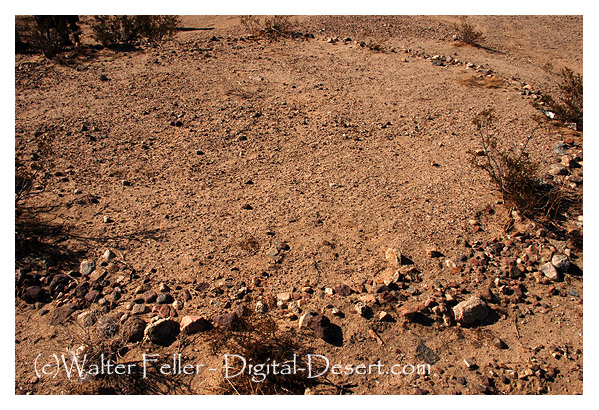Cleared Circles and Rock Rings

So-called "sleeping circles" are features, often circular in shape and typically 1.5-3.0 meters in diameter, that were formed by clearing away the rocks from an area of desert pavement or by enclosing an area within a low rock border. Thousands of such features are known from the California deserts. In one 9 mi.2 area in eastern San Diego County, Malcolm J. Rogers (1939:7) counted more that 500 circles. Interpretations of the origins of the features have included prehistoric camping areas, geoglyphs, and locations of ritual activity. Some features may have been produced by modern activities or by natural processes.
Rogers (1939, 1966) argued that the features could be assigned, at least primarily, to the earliest phase of the San Dieguito complex, which he also termed the Malpais Industry. This age assignment was based, in part, on the absence of any Late Prehistoric artifacts in association with the circles and their frequent occurrence in locations remote from any modern water source. The features were interpreted as "sleeping circles," within which the early hunters had slept "like sardines in a can" (Rogers 1966:14). The absence of artifacts within or near most of the features was taken to indicate that they were temporary sleeping areas rather than more permanent abodes (Rogers 1939:8).
Robert S. Begole (1973, 1974, 1976, 1981, 1984) conducted investigations for several years in the Anza-Borrego Desert State Park. He argued that sleeping circles in that region dated both well back into the Pleistocene and from the later phases of the San Dieguito complex as well. Many of the features were interpreted as living areas, extensively reused and with added "rooms." In other cases, Begole noted the association with apparent ritual functions, such as trail shrines, geoglyphs, and presumed vision quest areas. Jerry Schaefer has suggested that many of Begole's features were natural rather than cultural products (Laylander et al. 2015).
It is plausible to suppose that some of the region's sleeping circles may have been geoglyphs rather than habitation areas. Geoglyphs, or ground art features of various sorts, have been reported in considerable numbers in the Colorado Desert (e.g., Rogers 1939; Solari and Johnson 1982; Von Werlhof 2004). Many were formed by clearing away areas of desert pavement or by placing rocks into linear patterns, in manners comparable to the ways the sleeping circles were formed. Many of the geoglyphs are recognizable as such because they are representational in form or take geometrical shapes that seem to be clearly nonfunctional, beyond serving a ritual or artistic impulse; other geoglyph shapes are more ambiguous. Circles are a common design element for the region, frequently employed in rock art (Hedges 1970) and in pottery decoration (Rogers 1936).
Some Quechan have described small (0.5-1.5-meter-diameter) rock circles and cleared circles as having served as power circles or vision quest circles (Baksh 1997; Cleland 2005: Ezzo and Altschul 1993; Johnson 1985; Pigniolo et al. 1997).
Some rock rings have been interpreted as granary foundations (James 1995; True et al. 1991; but cf. Laylander and Christenson 1998).
Some apparent sleeping circles may be residues of recent activity. "Macahui," a concentration of such clearings in northern Baja California, was popularly identified, variously, as a major prehistoric town, a ceremonial center, or a vast cemetery (cf. Möller and Aguilar 1982). Closer studies showed that the features consisted, at least in considerable part, of modern gravel collection areas (Bendímez et al. 1986). A controversy has also long surrounded the "Topoc Maze" on the Colorado River, which may be an elaborate geoglyph or another modern gravel collection location (Haenszel 1978; Musser-Lopez 2011; Rogers 1939).
The possibility that some of the cleared circles are natural rather than cultural phenomena has been raised (cf. McAuliffe and McDonald 2006). Animal burrowing, the growth of bushes, sweeping of areas by wind-blown bush branches, and soil action are possible sources of some misleading patterns.
Several archaeological tests for distinguishing the functions of desert pavement clearings were suggested by Julia Bendímez, Don Laylander, and Héctor León (1986) to evaluate the disputed origins of the Macahui circles. The location of features in settings that lack water and other resources and that are off of any natural travel route would argue against habitation use but would not be inconsistent with geoglyph construction. Large, dense concentrations of the features would also seem to argue against habitation use, unless a taboo against the reuse of habitation circles is assumed. An absence of associated artifacts would argue against habitation use, or at least, as Rogers suggested, against any but a very transitory habitation use. Clearings that were made as geoglyphs or by gravel collectors would presumably favor specific sites with particularly dense desert pavement, whereas clearings made for temporary habitation would presumably be situated to minimize the amount of effort needed to clear them. If the cleared rocks are not accounted for within the surrounding pavement, the hypothesis of an origin in modern gravel collection or perhaps some noncultural phenomenon would be favored. The presence or absence of patination or desert varnish on moved rocks near the features might clarify the matter of their antiquity.
PROSPECTS
Future archaeological investigations may be able to clarify the purposes for which cleared circles and rock rings were constructed, as well as their chronology. Relevant evidence will include detailed documentation of the features, their settings, and their contexts with respect to other features, artifacts, and alterations in the natural pavements.
-- San Diego Archaeological Center --